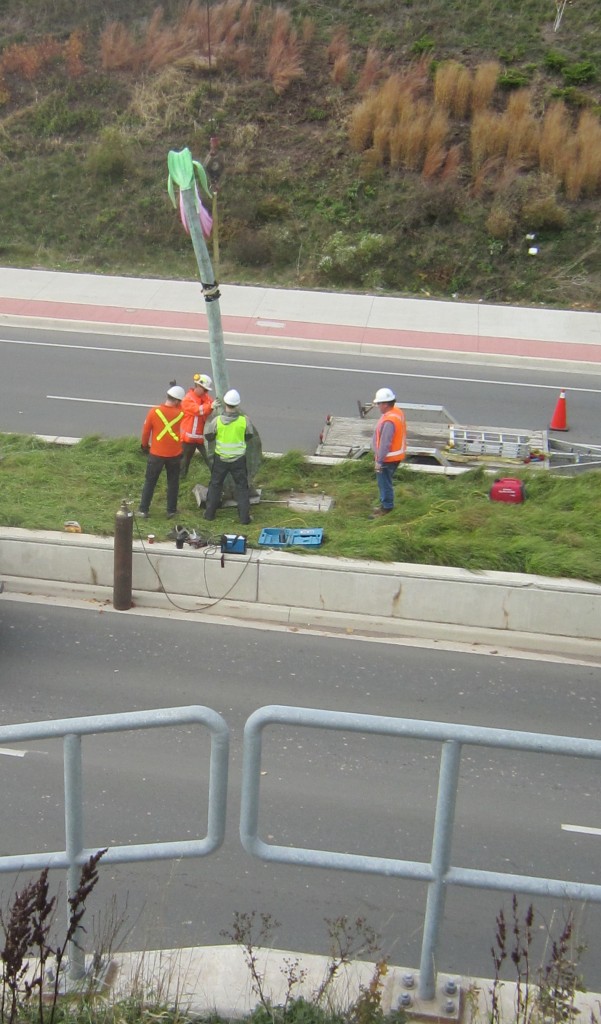BURLINGTON, ON November 14, 20111 Have you ever had one of those days where you were probably better off just staying in bed? That was sort of the situation with the unveiling of the “orchids” that were set up on Upper Middle Road immediately to the west of the railway underpass west of Appleby, which is a part of Burlington that is coming together quite nicely with all kinds of construction on Appleby Line.
There was to be a formal setting up of three large metal orchards which were part of a “public art” program. These three orchards had a price tag of just over $100,000. But that wasn’t the funny part.
They were originally to go up on November 9, but that date got pushed back to the 14th – Media were told there were some “transportation” issues. These things happens. The event was to take place at 1:00 pm and a collection of city councillors and staff were on hand to have their pictures taken with these three six-metre tall bronze and stainless steel sculptured orchids. Interesting bit of art and a lot more understandable than whatever it is they call it outside the Burlington Art Centre.
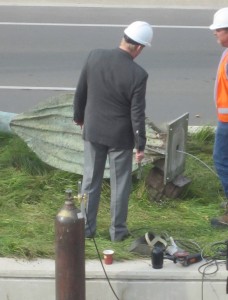
Councillor Sharman, with wrench in hand looks at the bolt holes - which weren`t quite large enough for the bolts. Ooops!
On November 14th, the “orchids” were carefully taken off the trucks that were transporting them. The city had placed concrete pads in the ground with sturdy bolds that would keep the pieces upright and in place. We were told later that the bolts were 25 mm wide and that there were eight of the things for each orchid. It all looked pretty solid – however, when it came time to set the orchids on their bases – guess what? The holes in the base of the orchid that the bolts were to go through was only 20 mm wide. Ooops!
Someone had to get a drill real fast and make those hole bigger – easier said than done. The plates at the base of the orchids were more than an inch of steel thick. This was not going to be easy. But whoever was doing the actual work got it done – not all of it – but enough for the pictures to be taken and the first of the orchids went up and the photo-op types went back to their offices.
The three six-metre tall bronze and stainless steel orchids, painted in bright colours are installed near the underpass on Upper Middle Road. One can understand the intention, but the orchids are just a little difficult to appreciate by people driving their cars and there isn’t much in the way of pedestrian traffic in that part of town. A driver is on a road that dips down to go under the rail line and there really isn’t time to look up and appreciate the public art.
The intention was good – the placement of the art – not so good. Getting the art from Cork Ireland, where they were made, was almost as awkward as installing the art on Upper Middle Road.
Art and a community is never easy. There are still people in Toronto who don’t like the Moore sculptures in their city hall square. Art is very personal – it soothes or challenges your sense of taste – and is often confrontational and challenging; that’s what art is supposed to do.
Burlington engaged a company in London Ontario to handle the selection of an artist, thus getting the decision out of local hands, where there would have been all kinds of pressure for someone local. That was a good move and some informed, sophisticated people were involved in that process which went very well.
Burlington did all the right things with this project. They went international when looking for artists, and when the jury selected someone from Ireland, there was the expected noise from local people about not giving our own people a chance. Our own people do quite well internationally, thank you.
The work, done by Alex Pentek of Cork Ireland who won the competition over 50 other entrants, was more than a year in the making.
In 2010, artists from across Canada and other countries submitted Expressions of Interest to design public art to complement the Upper Middle Road median between Appleby and Walker’s lines.
Proposals were reviewed by an independent public art jury — which included practicing arts professionals and representatives from the local community. The city allocated $100,000, plus consulting fees, for the city’s first public art project meant to complement the Upper Middle Road grade separation — a $15.4 million project completed earlier this year.
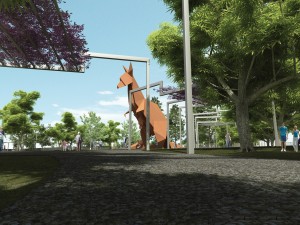
This design was shortlisted in an international competition for a landmark public sculpture overlooking Kangaroo Point, Brisbane, Australia. While not selected, this idea gained an underground following with its own anonymous web site: www.roozilla.com
The Expression of Interest, or the call to artists, was advertised in several forums, including: the Community Planners, Inc.’s and City of Burlington’s websites; an e-mail sent by the Burlington Art Centre to all of its members; paid advertisements in Akimbo, a professional artists website, and the Burlington Post; requests to other Burlington arts organizations and Oakville’s and Mississauga’s arts councils to notify artists; as well as word of mouth.
One can understand why the jury looking into the work of the 50 artists that sent in submission to the Expression of Interest were excited when they saw the work of Alex Pentek. The artist has an international following and has done some hugely imaginative work that is quite exciting. Burlington just might become one of the few places in the world that has a “Pentek” .
The city budgeted $100,000 for the public artwork — which included the artist’s travel and accommodation in Burlington — is part of the $15.8-million project budget for the construction of the Upper Middle Road underpass. The commissioning of public art for Upper Middle Road is part of the city’s Public Art Master Plan of which the rather smart looking bicycle racks scattered throughout the city are also a part. Mostly local people did that work.
Beating out nearly 50 artists in Canada and internationally in a city-run art contest, the Cork, Ireland resident says he came across the project on the professional artist website Akimbo while in the process for looking for work internationally.
Pentek has been making large-scale and site-specific sculptures for 15 years and his works have ranged from a six-metre tall illuminated sculpture of a dandelion made from bronze and fibre optic cable to a 12-ton steel hedgehog — Orchids is his first Canadian-featured piece.
Once the pieces were completed and ready (earlier in October), they were transported in shipping crates from Cork to Antwerp in Belgium and then to Halifax, N.S. From there, they were sent to Brampton by train and eventually Burlington by truck, arriving last Friday (Nov. 11). Needing a day to inspect the pieces, Pentek oversaw the final installation of the three orchids..
When asked what he thought of Burlington, Pentek said he was happy to see a level of art appreciation in the community. “Coming from the outside, I see a very interesting community keen on preserving cultural heritage and encouraging the arts,” he said.
When news of the orchid sculptures was first released by the city last year and its selection of an international artist, several residents sent letters and comments to the Post explaining their frustration over the city not featuring a local artist for the project.
But Riley says residents have it all wrong. “I like the piece for its concept and its historical and geographical significance,” said Riley. “It goes beyond the mundane and it’s an excellent piece for Burlington.”
“It’s important to not only have local artists featured in our city, but we need to bring international artists here too,” he explained. “Not only will it diversify our culture, but it will also encourage our artists to go outside of our area and be recognized internationally — this is a key point our community doesn’t understand. It’s important for our artists to expand.”
Andrea Halwa, vice-president and cultural manager of the London, Ont.-based firm Community Planners Inc., was hired by the city to plan and implement the underpass art project as well as oversee the artist selection process. She has been the executive director for the London Arts Council for more than eight years, overseeing the administration of London’s community arts investments and public art programs.
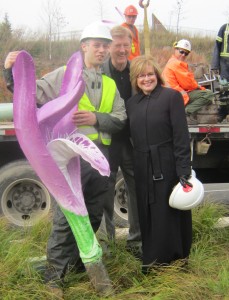
The Photo Op - Artist Alex Pentek on the left, displays a portion of the Orchid to Councillors Sharman and Lancaster
She lists her extensive arts experience to include being “a professional member” of Americans for Arts and its National Public Art Network, as well as a loose knit group of public art managers across Canada. Halwa also has a teaching position within the arts management program at the University of Western Ontario.
It was this experience, Halwa says, that drew the interest of the Burlington-based Carrie Brooks-Joiner and Associates to contact her to act as an associate for developing the Burlington Public Arts Master Plan — and eventually why the city selected her to oversee the jury and artist selection process.
The jury consisted of Wayne Moore and Deborah Pearce, Ward 6 resident Scott Arbuckle and Brian Meehan, executive director and chief curator of Museum London in London, Ont.
When asked how the process worked, Director of Burlington Parks and Recreation, Chris Glenn, explained that “in this case Community Planners Inc., would have been charged with the selection process, which would have used a level of consultation from our staff, a member who was connected (to the project) at that time… they have since moved on,” Glenn said. “They would have had a dialogue with respect to number and type of person/artist that we would need with a certain skill set to align with the type of work in mind and… a bit of knowledge base of Burlington. They would then start to go through a process, to find some people and ask them to volunteer on the jury… in this case we were looking for someone with experience in bigger structures.”
We have cribbed extensively from the Burlington Post for this piece and want to include portions of an editorial they ran.
There was a lot of noise about the delays and the process that was used to select the artist – that’s all part of what a community is. Not possible to keep everyone happy. One of the local media certainly wasn’t happy with the choice of artist and let their provincialism show when in an editorial they said:
Surely we had a skilled sculptor living in Burlington who could have produced something as equally spectacular. If no one in Burlington was capable of taking up the challenge are we to believe that Canada does not have an artist talented enough to spearhead a special creation? But, no, our tax money was spent outside of the country.
Heck, we apparently don’t even have the expertise to set the art selection process in motion. That $20,000 job went to a London, Ont. company.
We know that art has no geographic boundaries. However, the city could have stressed the artwork must be made in Canada. What’s wrong with that?
Well just what is wrong with that? It is a very provincial outlook and not what the art world is all about. A number of Burlington artists are recognized world-wide and Burlington has, with the installation of the orchids recognized a world class artist.
Halwa made an important point when she said of the kerfuffle in local media: “It’s interesting, we have a very good working relationship with the media and our process for these types of programs is really transparent; I really hope that Burlington has adopted the approach for other public art projects as every project is going to have an artist that feels it should have been “his” project or “her” project or they could have done a better job, etc. The process we use has the jury making the decision and the jury is a mix of community folks, artists, arts administrators, etc. so it is not a process that can really be tampered with. Alas, ‘can’t win ’em all’ really applies here.”
The public got to here from the artist when Pentek spoke at the Burlington Art Centre about his work where he explained the importance of having public art that is unique and meaningful to Burlington during a recent meet-and-greet at the city’s art centre last Sunday.
“With a practice focused on making large-scale commissioned work over the past 15 years, as well as temporary gallery-based work, I’m very excited to work on a project that can create a sense of community through a legacy of shared experience,” Pentek said in an interview at the Burlington Art Centre, where he presented his design of three six-metre tall bronze and stainless steel orchid sculptures.
During his presentation to a room of nearly 20 people, the Irish artist did admit coming up with a design for the project had challenged him a bit.
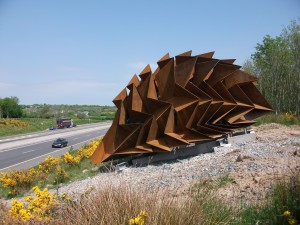
Pentek, the winner of the Burlington public art competition has always focused on outdoor work. An example of one of his pieces is shown above.
“For one I couldn’t get great images of the site and number two, I have to admit, the site really didn’t inspire me,” he said. “The infrastructure was fully functional, but something had to go in here to lift it up.”
That’s why Pentek says he decided to go for a more colourful and realistic look to his orchids as opposed to a more metallic design.
“It would have been easier to work in monochrome, single-tone structures, but I felt that given where it’s going and the concrete around, the pieces needed to lift the area with vibrant colours,” he said.
The design for Pentek’s Orchids was loosely based on his previous successful work on the illuminated dandelion he did in Cork, he says, which used bronze and fibre optic cables.
Pentek researched various orchids from Burlington’s horticultural history and during a 2010-trip to Burlington, Pentek met with a Royal Botanical Gardens team to view pressed and refrigerated samples of flowers, as well as meet artist Georgian Guenther to view her smaller representations of orchids.
He finally settled on three orchids that were once native to Burlington, including the Cypripedium acaule, commonly known as Pink Lady’s Slipper, Arethusa bulbosa (Dragon’s Mouth), and Triphora trianthophora (Three Birds).
“It has been my aim to create this site specific work by celebrating the rich natural heritage of the local area through the diversity and delicacy of these wild orchids whose stillness and organic forms will visually complement the surrounding rail and road traffic infrastructure in an uplifting and light-hearted way,” Pentek said.
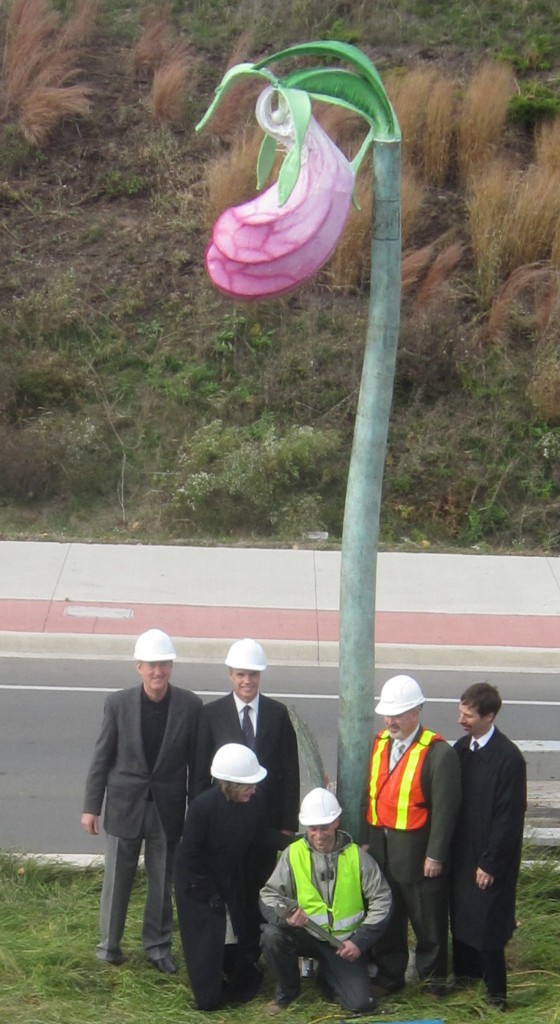
Civic officials and politicians gather around the $100,000 piece of public art. Can you name all of the usual suspects. The artist in the center holds the large wrench used to tighten the nuts on the bolts once the holes for the bolts were enlarged.
Totaling six pieces, the orchid structures are made up of three bronze stems sealed with beeswax and three bulbs/flower tops.
Although the pieces are weather protected, Pentek says the stems may have to be touched up every year or so. The flower tops are painted with urethane paint, a strong, robust outdoor paint — which have been supplied to the city by the artist for any future touch-ups — and covered with a polyurea protective coating that Pentek says should withhold Canadian winters.
“I did not want to have them lacquered (a clear or coloured varnish) because if there was the slightest bit of movement, the paint on the pieces would crack,” he explained.
Pentek went on to assure his audience that the fibre optic and low-cost, low-maintenance LED lighting worked into the construction of the orchids will be more a subtle accent to the surrounding street lighting at night, rather than a distraction to drivers.
“It won’t be strong enough to illuminate the street on its own,” he said. “As you’re walking you’ll clearly see them lit, but you won’t be dazzled by them when driving.”
Pentek has been practicing as a full time artist both nationally and internationally since he graduated from the Crawford College of Art & Design, Cork, Ireland in 1996. He has focused on creating large scale site specific work, and has also made temporary gallery based works in paper and sound performances.
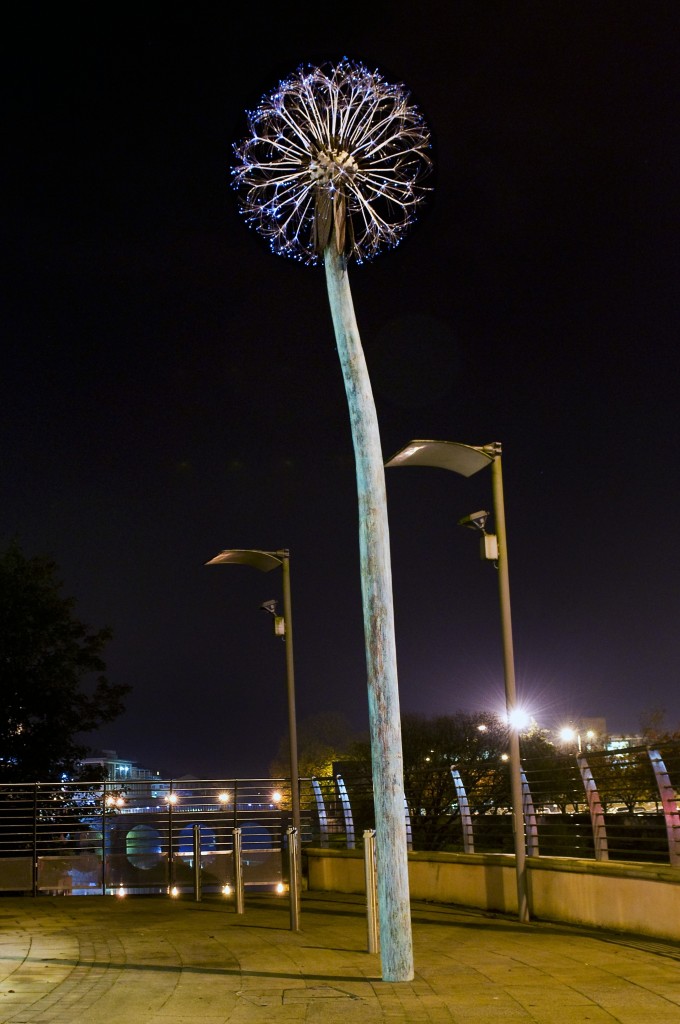
Public art can be astonishingly attractive. This piece, done by Pentek is an example of his work. Burlington`s Orchids, will in time become part of the local scene.
“I like to stay abreast of current scientific and mathematical theories, and elements of these inform my working practice on a practical and philosophical level. The study of light through Holography is an area of particular interest to me where information about the ‘whole’ is contained within each smaller ’part’ encoded by laser light interference patterns. I am also interested in the question of the emergence of life in Earth‘s early oceans, where complex systems achieved order not through top down commands but through a bottom up grass roots level of interaction. (Similar ‘passive dynamic’ systems can also be found working in today’s communities in the natural world, from ant colonies to the formation of modern cities). I enjoy exploring these holistic and interactive ideas, which are relevant to the relationship between ‘self’ and the surrounding ‘community’ and World in which we live.
“While the ideas behind each work vary greatly, the work is interpreted just as differently and validly by all who experience it. It is my aim to create openly challenging and engaging work that not only explores different themes and ideas but that also communicates on a more primary visual level.”
The key word there is “challenging”; that is what art is all about. Artists bring what is possible to us; they force us to look at things differently and while that may make us a bit uncomfortable it also enriches the mind and the spirit.
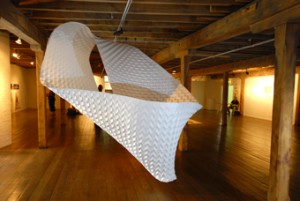
Not all of Pentek`s work is displayed outdoors. This paper mobile has an evocative look and feel to it.
“As I mainly make large scale permanent work, the processes behind realizing any project are an important part of the work. Using my own set of skills as an artist where possible (such as drawing and sculpting / casting in various materials); I enjoy the challenge of working to a large scale by drawing on the skills and expertise of architects, engineers and fabricators to realize a project. Also, often introducing an idea to the local community through public consultation, communication and people skills become important to the success of a project as well as expertise in the finished material of the work itself.”
Our Mayor, in his press release said: “Burlington is an innovative and progressive community, built upon a strong sense of community pride. Public art projects like Orchids help give shape to that pride. We’re excited to see such an impressive art project come to life.”
The public chatter overt the Orchids just might move The Pier off the front pages for the Pier will eventually get built band it will be loved by all – but those orchids will stick in the craw of many for a long time. Fortunately the artist lives in Ireland and he won’t have to put up with all the noise. The Mayor makes an important point when he says public art helps give shape to who we are – it also draws out comment that – well perhaps the words were better left unsaid.
Are the Orchids good art? That’s for you to decide. They just might grow on you.














